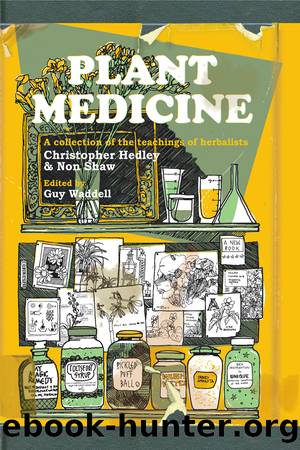Plant Medicine by Hedley Christopher;Shaw Non;Waddell Guy;

Author:Hedley, Christopher;Shaw, Non;Waddell, Guy;
Language: eng
Format: epub
Publisher: Aeon Books Ltd
Published: 2023-08-08T00:00:00+00:00
Other strategies for pain
Explanation; giving the patient a clear explanation (in words which they understand) is the starting point. Pain tends to scatter people and they need a focus. Explanations could be based on the above analysis, on humoral analysis or on emotional or psychic causesâalways listen carefully to the patient's own story before attempting this.
Exercise; any exercise thins the blood and reduces inflammation. Stretching exercises reduce spasm. Getting moving and out in the world brings back self-confidence and reduces depression. Strengthening muscles helps take the load from ligamentsâespecially useful in tendonitis, congenitally weak ligaments (hypermobility), and ligament dense areas of the body such as the back and shoulders. Such exercise should be carefully thought out, and it is probably best to ask for help from a good body worker or physiotherapist.
Massage and Passive Exercise; it is well worth learning some, gentle massage skills to help your patients. At one time herbalists integrated some sort of body work into their practice. Massage is useful because it brings the patient back into their body and provides passive exercise, clearing inflammation without bringing strain.
Exercise; exercise should be of course, always be gently paced. Get the patient to set achievable goals for themselves and encourage them never to overdo any particular exercise or activity. Get them to change activities often, i.e. never sitting still for too long by getting up and walk around a little.
Reintegration; we tend to try and cut ourselves off from painful areas and experiences, thus preventing our vital spirit from healing. Bring the patient's attention back to the painful area by teaching them âbreathing throughâ techniques, by making sweet smelling creams to gently rub in, and by using creative visualisationâor simply by talking, out loud, to the afflicted part.
Relaxation Techniques; these can be both physical and mental including; visualisation, relaxation tapes, music, meditation, yoga, tai chi, etc. Learn or try as many of these as you can so that you can more usefully advise your patients. Bad posture needs to be addressed as it builds tension into the body.
Counselling and Psychotherapy; the basic coaching skill is to listen to your patient, without engaging in a conversation or offering adviceâgive them the space they need to express all their fears and worries. Once they have reached their true fears, you may feel the need to refer them on to a therapist in order to address those in particular.
Emotional problems are held in our bodies, and the emotion underlying any pain needs to be attended to. The best therapies integrate mental and body work, e.g. Heller work. Dowsing for flower remedies is a good way of exploring any emotional issues that may lie behind the physical illness. You can also choose flower remedies to go into a healing cream.
Reducing Medication; pain killers make pain worse. They induce the nervous system to set up its sensitivity, so any reduction is beneficial. On the other hand, pain causes stress, causing illness, so patients should be encouraged to use whatever medication they need to bring the pain back to a bearable level.
Download
This site does not store any files on its server. We only index and link to content provided by other sites. Please contact the content providers to delete copyright contents if any and email us, we'll remove relevant links or contents immediately.
| Acupuncture & Acupressure | Aromatherapy |
| Ayurveda | Chelation |
| Chinese Medicine | Energy Healing |
| Healing | Herbal Remedies |
| Holistic | Homeopathy |
| Hypnotherapy | Massage |
| Meditation | Naturopathy |
| Reference |
Inner Engineering: A Yogi's Guide to Joy by Sadhguru(6633)
The Power of Now: A Guide to Spiritual Enlightenment by Eckhart Tolle(5544)
Fear by Osho(4619)
Ikigai by Héctor García & Francesc Miralles(4044)
The Art of Happiness by The Dalai Lama(4009)
The Ultimate Bodybuilding Cookbook by Kendall Lou Schmidt(3854)
Yoga Therapy by Mark Stephens(3668)
The Little Book of Hygge by Meik Wiking(3515)
The Healing Self by Deepak Chopra(3405)
Why Buddhism is True by Robert Wright(3372)
The Hatha Yoga Pradipika (Translated) by Svatmarama(3184)
Being Aware of Being Aware by Rupert Spira(3170)
Shift into Freedom by Loch Kelly(3098)
Wild Words from Wild Women by Stephens Autumn(3041)
Work Clean by Dan Charnas(3006)
Happiness by Matthieu Ricard(2959)
More Language of Letting Go: 366 New Daily Meditations by Melody Beattie(2941)
Yoga Body & Mind Handbook by Jasmine Tarkeshi(2810)
Why I Am Not a Feminist by Jessa Crispin(2666)
